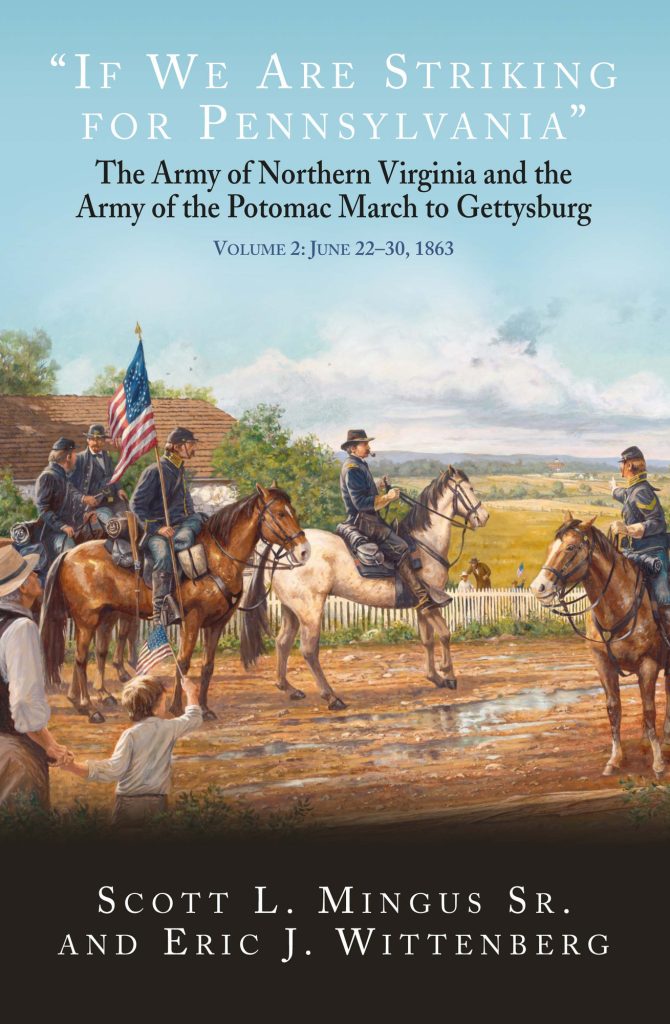Book Review: “If We are Striking for Pennsylvania:” The Army of Northern Virginia and the Army of the Potomac March to Gettysburg, Vol. 2: June 22-30, 1863

 “If We are Striking for Pennsylvania:” The Army of Northern Virginia and the Army of the Potomac March to Gettysburg, Vol. 2: June 22-30, 1863. By Scott Mingus Sr. and Eric J. Wittenberg. El Dorado Hills, CA: Savas Beatie, 2023. Hardcover, 444 pp. $34.95.
“If We are Striking for Pennsylvania:” The Army of Northern Virginia and the Army of the Potomac March to Gettysburg, Vol. 2: June 22-30, 1863. By Scott Mingus Sr. and Eric J. Wittenberg. El Dorado Hills, CA: Savas Beatie, 2023. Hardcover, 444 pp. $34.95.
Reviewed by John G. Selby
The much-anticipated volume 2 of the March to Gettysburg series is now available. Once again, the award-winning team of Mingus and Wittenberg have created an exciting narrative that in this volume brings the reader to the battle itself. As always with these historical writers, the depth and breadth of the primary sources are remarkable, ranging from free black farmer to white housewife to Confederate private and Union general. Most commendable is the ability of the authors to keep control of the narrative while using hundreds of different sources, including letters, diaries, memoirs, newspapers, government documents, military records, and secondary sources. Arranged chronologically, the reader is swept along by the rapid pace of events and ironically, by knowing what the participants did not: the biggest battle of the war was soon to begin.
Several themes emerge in the wide-ranging narrative. First, the vast extent of plundering committed by the Confederates. General Robert E. Lee’s famous General Order 73 (prohibiting plunder) was honored more in the breach than the observance. While many soldiers offered Confederate money or receipts for goods, most just took what they wanted. The demand for tribute emanated from the top (except Lee). For example, Major General Jubal Early arrived in York, Pennsylvania at noon on June 28 and requisitioned: “165 barrels of flour or 28,000 pounds of baked bread, 3,500 pounds of sugar, 1,650 pounds of coffee, 300 gallons of molasses, 1,200 pounds of salt, and 32,000 pounds of fresh beef or 21,000 pounds of bacon or pork.” Additionally, Early’s quartermaster demanded “2,000 pairs of shoes or boots, 1,000 pairs of socks, 1,000 felt hats, and $100,000 in greenbacks.” (219) Early settled for $28,610, writing a receipt for that amount. Similar tribute was asked of each town the Confederates passed through, while the scouring of the countryside for horses, food, valuables, and black citizens (to enslave) went on to such scale it was not even officially recorded.
A second theme is fear. Pennsylvanians were panicked as the Confederate armies tramped through their countryside, and both Governor Curtin and President Lincoln were besieged with requests to stop the soldiers. With the mobilization of Pennsylvania and New York militia units, a concentration of force occurred in Harrisburg, and combined with the destruction of the critical Wrightsville Bridge across the Susquehanna River by Union forces, Harrisburg was spared.
The third theme is uncertainty. Not only were Union generals and politicians in the dark about Lee’s movements and plans, but Major General Joseph Hooker kept the whereabouts of his corps known only to him. As Lee’s army marched relentlessly northward, President Lincoln grew so exasperated with Hooker that he accepted Hooker’s resignation, thus placing command of the widely dispersed Army of the Potomac on Major General George G. Meade’s shoulders when information on Lee’s plans were virtually unknown. Charged with protecting Washington and fighting Lee, Meade moved quickly to send his corps into southern Pennsylvania. Meanwhile, Lee was also operating in the dark, as the bulk of his cavalry was on a long ride around Union forces and then back up into Pennsylvania. Mingus and Wittenberg provide a compelling account of Major General Jeb Stuart’s controversial ride, wrestling with the age-old questions of responsibility and interpretation of orders.
The final theme is the broader ramifications of the Gettysburg Campaign. The authors examine the role that the ill-fated expedition of Major General John Dix to capture Richmond played in the decisions made by Confederate leaders, as well as the international implications that a major victory by Lee’s army in Pennsylvania might have had for the future of the Confederacy. On the Union side, the authors point out that while many politicians in Washington were terrified by the Confederate invasion of the North, others saw an opportunity to catch Lee’s army in a moment of vulnerability far from its base in Virginia.
Though some question the purpose of studying history when the outcome is known, a careful and curious reader will be rewarded for knowing the future for these soldiers and civilians, because it gives drama and poignancy to the events leading towards the grand battle. With their granular approach to the march on Gettysburg by both armies, Mingus and Wittenberg have uncovered an aspect of the much-studied battle that needed more attention.
John G. Selby is retired as a professor of history at Roanoke College and the former holder of the John R. Turbyfill Chair in History. A Civil War scholar, Selby wrote: Meade the Price of Command, 1863-1865; Virginians at War: The Civil War Experiences of Seven Young Confederates; and coedited Civil War Talks: Further Reminiscences of George S. Bernard and His Fellow Veterans.
Both volumes have added significantly to my appreciation of the overall campaign. I agree with the Professor’s characterization of the four main themes of Volume 2.
Thank you for the very kind words about our work, Professor Selby.
A good read!!
An excellent book that I received for Father’s Day and have started reading!
Sounds like an interesting book covering a lot of ground. By the way, cheers to Roanoke College, Professor Selby.
Thanks so much for the kind words about our new book!